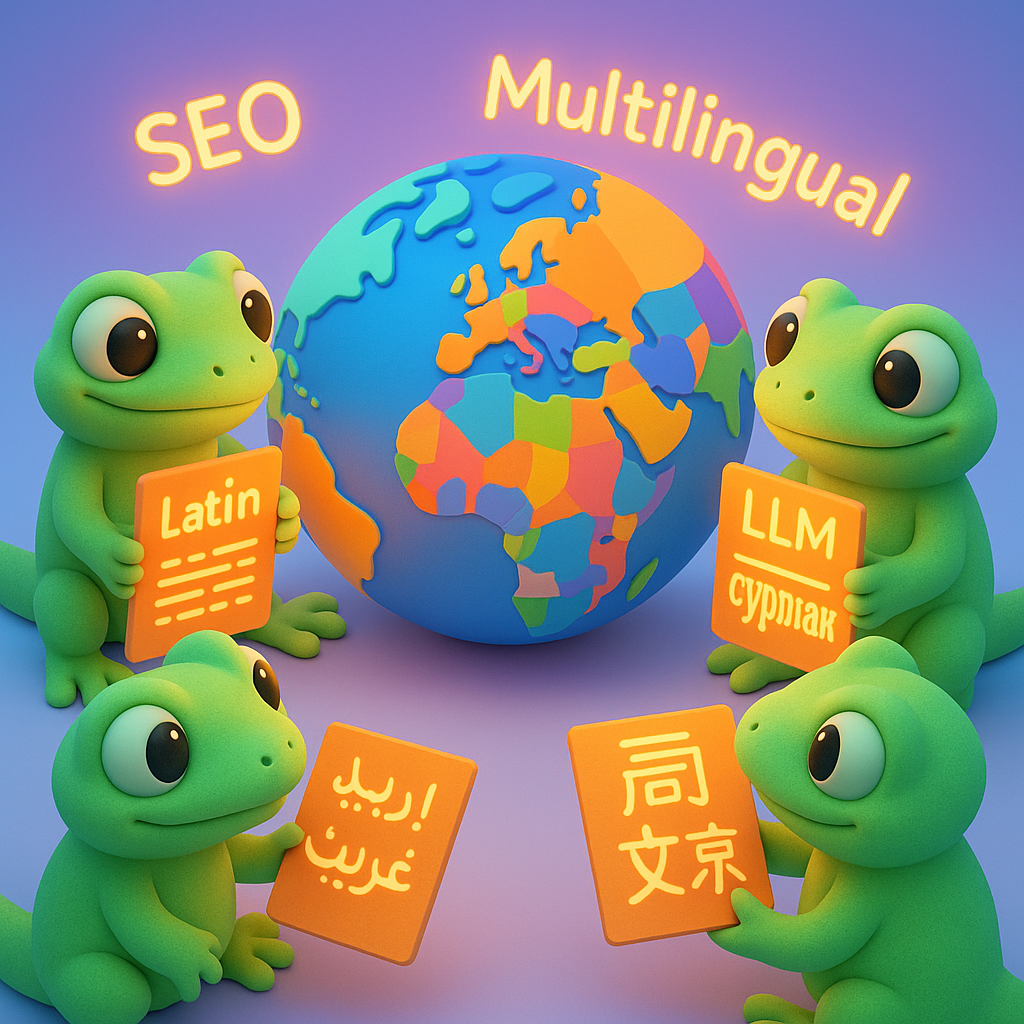Challenges of LLMs for Multilingual Websites in SEO Strategies
Large language models (LLMs) are transforming search through AI-powered platforms like Perplexity, ChatGPT, and Google’s AI features. However, deploying these systems on multilingual websites introduces substantial technical and linguistic hurdles that impact SEO performance and content strategy. For marketing leaders and SEO professionals navigating this landscape, understanding these challenges is crucial for effective large language model optimization.
The curse of multilinguality
One fundamental challenge is what researchers call the “curse of multilinguality” – the phenomenon where adding languages beyond a certain threshold dilutes per-language performance. This occurs because model resources are spread thin across languages, with low-resource languages particularly affected. According to research from arxiv.org, this resource dilution significantly impacts accuracy in non-dominant languages.
Think of it like trying to become an expert in multiple sports simultaneously – each additional sport divides your training time and focus, making mastery of any single one more difficult. In practical terms, this means that a model trained on 100 languages may perform worse on Finnish or Swahili than a model specifically trained for those languages.
This creates a strategic dilemma for multilingual websites: whether to use a single large model across all languages or deploy language-specific models. The former risks diminished performance in certain markets, while the latter increases complexity and costs.
Language structure and script challenges
LLMs face several linguistic obstacles when operating across multiple languages:
Grammatical and syntactic diversity
Languages differ fundamentally in structure – from tonal languages like Mandarin (where pitch changes meaning) to the complex case systems of Slavic languages (with noun forms changing based on grammatical function). This diversity creates barriers for static prompt strategies and embedding techniques that are typically optimized for English.
For example, a prompt structure that works perfectly for English might fail in Japanese, where the subject often comes last in a sentence. As noted in research from 2023, these differences require dynamic adaptation rather than one-size-fits-all approaches.
Non-Latin script handling
Models particularly struggle with non-Latin scripts such as Arabic (right-to-left), logographic systems like Japanese, or complex scripts like Thai (which lacks word boundaries). Performance metrics show dramatic differences, with bi-lingual models achieving less than 5% F1 scores on Indic language question-answering tasks, while dynamic approaches can reach 50-60% without fine-tuning.
This disparity has direct SEO implications – if an LLM struggles to understand content in certain scripts, it may fail to properly index, summarize, or retrieve that content in search results, creating an inherent disadvantage for non-Latin script websites.

Technical implementation challenges
Beyond linguistic issues, several technical obstacles complicate multilingual LLM deployment:
Retrieval and citation inconsistency
When tools for monitoring LLMO performance analyze cross-lingual retrieval, they reveal that document language composition significantly affects response consistency. While Retrieval-Augmented Generation (RAG) improves factuality, it can introduce variability in multilingual contexts.
For instance, when querying about territorial disputes, an LLM might retrieve predominantly English sources for an English query but Japanese sources for the same query in Japanese, potentially leading to different perspectives in the response. This means SEO professionals must carefully monitor how their content is cited across languages.
Training data imbalance
Limited resources for low-resource languages create performance skews that impact search visibility. The most widely spoken languages enjoy abundant training data, while others suffer from data scarcity. According to medical research on multilingual LLMs, strategic alignment approaches sometimes outperform simple scaling laws, suggesting that quality matters as much as quantity.
Consider this practical example: an LLM might have seen millions of product reviews in English during training but only thousands in Slovak. When generating or analyzing content, this imbalance creates a performance gap that can affect search rankings and user engagement.
Integration with multilingual CMS
LLMs often have limited compatibility with multilingual CMS platforms and SEO tools, complicating content localization workflows. This creates friction in the content development process and can impede effective comparing traditional SEO vs LLMO techniques.
Many popular CMS systems were designed long before LLMs became mainstream, resulting in technical debt and integration challenges. Organizations frequently need custom development work to bridge these gaps, adding cost and complexity to multilingual implementations.

Performance and operational challenges
Operational concerns also affect multilingual LLM implementations:
Computational demands
Multilingual training requires significantly greater computational resources than monolingual approaches. This translates to higher costs and potential latency issues, particularly important for real-time applications like SEO tools and content generation.
To put this in perspective, while a single-language model might require tens of thousands of GPU hours to train, multilingual versions can demand hundreds of thousands of hours – a 5-10x increase in computational cost. For resource-constrained organizations, these demands may limit multilingual capabilities.
Knowledge editing complexities
Updating multilingual datasets (such as product information or medical guidelines) risks accuracy loss across languages. This requires careful content curation and version control to maintain consistency, especially for businesses operating in regulated industries or handling sensitive information.
For example, when a pharmaceutical company updates medical guidance in their primary language, ensuring those updates propagate accurately across 30+ languages is a substantial challenge. Inconsistencies can lead to compliance issues and diminished search performance.
Strategic implications for SEO professionals
These challenges create several strategic considerations for marketing leaders:
Balancing resource allocation
Organizations must decide how to allocate resources across languages, potentially prioritizing high-value markets while using less resource-intensive approaches for others. This mirrors traditional international SEO considerations but with additional complexity.
A practical approach might involve using advanced custom models for tier-one markets while leveraging more general multilingual models with simpler prompting for secondary markets. This tiered strategy can help maximize ROI on LLM optimization.
Monitoring cross-language performance
Traditional SEO metrics may not fully capture LLM performance across languages. Organizations need comprehensive monitoring frameworks that track metrics like citation rates, response accuracy, and hallucination frequency in each target language.
For instance, while English content might receive direct citations from an LLM, content in less-represented languages might be paraphrased or summarized without attribution. These differences require specialized monitoring to detect and address.
Content development strategy
Content teams must adapt their approach to address linguistic diversity, potentially developing language-specific content briefs rather than direct translations. Using a free keyword clustering tool can help identify language-specific search patterns and intents that vary across markets.
For example, search behavior around financial products differs significantly between cultures – some prioritize security features while others focus on convenience. Content strategies that account for these differences typically outperform direct translations.
Emerging solutions
Despite these challenges, several promising approaches are emerging:
Adaptive prompting techniques
Dynamic prompting strategies that adjust to language-specific characteristics show promise for improving performance across languages without requiring separate models. These techniques use metadata about the target language to modify prompt structure, compensating for linguistic differences.
A simple implementation might involve language-specific templates that account for syntax differences, while more sophisticated approaches might use language embeddings to dynamically adjust prompting strategies.
Transfer learning optimization
Strategic application of transfer learning techniques can help extend capabilities to low-resource languages more efficiently than training from scratch, potentially addressing the curse of multilinguality.
Companies like Meta have demonstrated success with this approach, creating models that perform well across hundreds of languages by strategically transferring knowledge from high-resource to low-resource languages. This offers a practical middle ground between single massive models and language-specific approaches.
Hybrid retrieval approaches
Combining traditional search techniques with LLM generation can provide more consistent results across languages, especially when paired with language-specific retrieval indexes.
For example, some systems now use language-specific BM25 or vector search before LLM processing, ensuring relevant documents are retrieved regardless of the query language. This addresses some of the retrieval consistency issues while maintaining the benefits of LLM-based content generation.
AI-powered content adaptation
Using specialized content writer generators that understand cultural and linguistic nuances can help create more effective multilingual content that resonates with local audiences while maintaining SEO performance.
These systems go beyond translation to consider cultural references, local examples, and market-specific concerns, creating content that performs better in both traditional and LLM search environments.
TL;DR
Large language models face significant challenges in multilingual environments, including the curse of multilinguality, linguistic diversity, script handling problems, retrieval inconsistencies, and technical integration issues. These challenges create performance gaps across languages that impact SEO strategies and content effectiveness. Organizations pursuing multilingual LLM optimization must develop specialized approaches that account for these differences, potentially leveraging adaptive prompting, transfer learning, and hybrid retrieval techniques. Effective measurement frameworks are also essential for tracking ROI of LLM optimization across different language markets.
